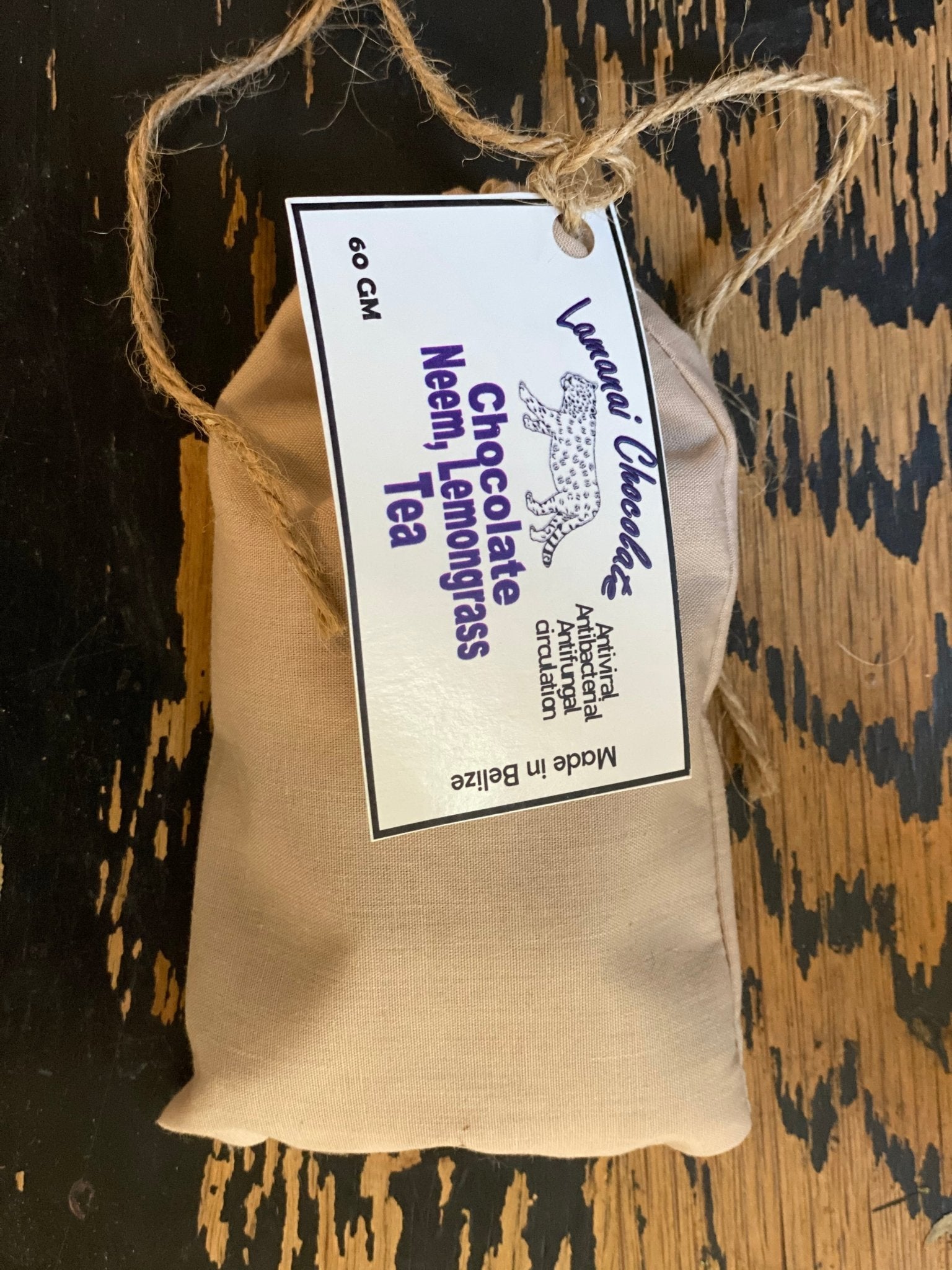From Lamanai Chocolate
Made by indigenous Maya using ancient fermentation processes, cacao beans are wrapped in banana leaves before they are sundried and roasted over an open fire
Maya Super Teas are available in two flavors!
- Cacao Neem Lemon Grass Tea - Used by the Maya as an antiviral blood cleanser, for skin irritation and to increase blood flow to the brain for mood enhancement and memory.
- Cacao Chaya Mint Tea - Used by the Maya to augment calcium, reduce weight and to prevent anemia because of iron content higher than spinach.
Delicious layers of smooth, rich cacao, fresh neem leaf, or mint/chaya and sweet lemon grass make for a decadent, whole leaf tea free of sugar and guilt. The incredibly rich tones in this formulation will make you fall in love! Endless health benefits, used as an antiviral blood cleanser, to reduce skin irritation and sickness. An immediate mood booster tea. Indulge your senses, cozy up with a mug, and sip to your heart's delight.
https://www.lamanaichocolate.com/
INFORMATION ON MAYA HERBS
The Maya ethno-medicine healing traditions (medicinal plants used by the Mayan Healers in the Peninsula of Yucatan and other Maya regions: Chiapas, Belize, Guatemala) are taught verbally by Mayan J-Men and actively practiced by Mayan healers from one generation to the next since Colonial times. Mayan healers use Mayan holistic rituals and healing ceremonies with prayer, divination, ethno-medicine traditions, and guidance from their spiritual guardians that communicate through dreams and their holy Sas'tun (quartz) holistic messages to cure, purify, or cleanse a person. Since the Spaniards burned almost all Mayan books and codices, J-Men and Mayan healers have little written records of their medicinal methods; today, few books by western writers have recorded some of the important Mayan ethno-medicine healing traditions, medicine plants, remedies, cures, and holistic practices. These are some of the sacred holistic Mayan flora in Yucatan, medicinal herbs, plants, roots, etc. use by J-Men or Mayan healers:
Chaya
The Maya miracle plant, has been used for food since pre-Columbian times, and is still eaten regularly, especially in Central America and southern Mexico.
Recent scientific studies confirmed what Belizean natural healers and Maya shaman have known for centuries – eating a small amount of Chaya after or as part of a meal will lower blood glucose levels.
A study conducted by the Mexican National Institute of Nutrition concludes that Chaya will not only combat diabetes but is also effective in treating arthritis. Another study conducted by Texas A&M University confirmed the anti-diabetic properties of Chaya. “Following the oral administration of chaya tea, the blood glucose levels of the diabetic rabbits were gradually lowered from a high of 118 (baseline at 0.0 h) to 87 six hours after administration. The blood glucose level of 87 is similar to blood glucose levels of normoglycemic rabbits on drinking water.”
Chaya (Cnidoscolus aconitifolius)1, sometimes called the spinach tree, is a fast-growing perennial shrub native to Belize and Mexico that produces lots of attractive, large, dark green leaves. It can grow well on a wide range of soils in both hot, rainy climates and areas with occasional drought. It grows easily and quickly, especially at higher temperatures, and new leaves grow quickly after harvesting. The amount of leaves per square foot of garden space is impressive (see photos). Leaves have lower moisture content than most other green leafy plants like spinach or lettuce.
Chaya has been extensively used as a medicinal plant. Usually cooked leaves are eaten, or teas or infusions are made from the leaves. Although many medicinal claims have been made for chaya, it is mostly used for diabetes and kidney problems. Ross-Ibarra and Molina-Cruz tell of a survey from 1991, done in the state of Morelos (Mexico), in which 85 people were interviewed. 60 used chaya for kidney trouble (e.g. leaves blended in a shake); 21 for diabetes (to lower blood sugar); 10 for ulcers, blood pressure and scorpion bites; and four for other purposes.
Chaya out-performs most other green leafy vegetables nutritionally. The leaves are very high in protein, calcium, iron, carotene and vitamins A, B and C. The amino acids in chaya are well balanced, which is important for those who have a diet low in protein and for children and pregnant or nursing mothers.
https://www.mexconnect.com/articles/982-chaya-the-maya-miracle-plant/
people.umass.edu/psoil370/Syllabus-files/Chaya.pdf
NEEM
Known as the "Miracle Tree," the Latin name for Neem is Azadirachta Indica, which literally means “Free Tree of India” where it has been revered for centuries because of its many agricultural and medicinal properties. Neem is a botanical cousin of mahogany belonging to the Meliaceae family and like mahogany, neem trees thrive in Belize and can live between 150 – 200 years.
Neem is so safe that it is used in many products including toothpaste, mouthwash, soaps, shampoos and many very effective medicines.
In India, it is often referred to as “the village pharmacy” and has been used in treating numerous health conditions for nearly 5,000 years. All parts of the tree are used in treating a variety of ailments such as skin diseases including acne and psoriasis. It is used as an effective treatment for parasites, rheumatism and arthritis. It has antiviral as well as anti-malarial, antibacterial, and anti-fungal properties. It is also used in the case of poisonous bites. The bark reduces fever, is a powerful diuretic and contains the anti-inflammatory properties. Neem can lower blood sugar in diabetics by approximately 50%, and is used to lower cholesterol as well as blood pressure preventing heart disease. It is used as a blood purifier and detoxifier. Research is ongoing and promising results have been found in treating as well as preventing AIDS and some cancers. It has been used effectively for hundreds of years as a safe alternative birth control by women and current research promises the first male birth control pill from neem. Neem is also an indispensable remedy for pets and farm animals, preventing tick and flea bites, as well as treating mange in dogs.
https://agreport.bz/neem-the-miracle-tree/
http://www.yucatanadventure.com.mx/yucatan-flora.htm










